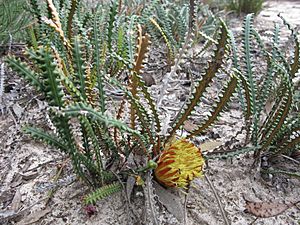Shining honeypot facts for kids
Quick facts for kids Shining honeypot |
|
|---|---|
 |
|
| Scientific classification | |
| Genus: |
Banksia
|
| Species: |
obtusa
|
| Synonyms | |
Banksia obtusa, commonly known as the shining honeypot, is a special type of shrub. It grows only in the south-west part of Western Australia. This plant has stems that grow underground. Its leaves are long and have small triangle shapes along their sides. The shining honeypot has cream-coloured or yellow flowers. These flowers grow in groups of up to seventy. Dark reddish leaves called bracts surround the flowers. After flowering, it produces egg-shaped fruits called follicles.
Contents
What Does the Shining Honeypot Look Like?
The shining honeypot is a shrub with unique stems that grow underground. Its leaves grow in clumps that can be up to 60 cm (24 in) wide. Each leaf is long and has many small triangular sections on both sides. These leaves are usually 150–300 mm (5.9–11.8 in) long and 6–17 mm (0.24–0.67 in) wide. They sit on a stalk about 20–40 mm (0.79–1.57 in) long. Each leaf can have between thirty and sixty triangular parts on each side.
Flowers and Fruits
The flowers of the shining honeypot are cream-coloured or yellow. They grow in a cluster, with about fifty-five to seventy flowers in one head. At the base of the flower head are dark reddish-brown leaves called involucral bracts, which can be up to 45 mm (1.8 in) long. The flower's outer parts, called the perianth, are 26–30 mm (1.0–1.2 in) long. The part of the flower that receives pollen, called the pistil, is 35–38 mm (1.4–1.5 in) long.
This plant usually flowers from August to November. After flowering, it produces egg-shaped fruits called follicles. These fruits are about 18 mm (0.71 in) long.
How Was the Shining Honeypot Named?
This plant was first officially described in 1810 by a botanist named Robert Brown. He gave it the name Dryandra obtusa. He published his description in a scientific journal called Transactions of the Linnean Society of London. The second part of its name, obtusa, comes from a Latin word meaning "blunt." This name might refer to the shape of its leaves or the small triangular parts on the leaves.
Later, in 2007, two other scientists, Austin Mast and Kevin Thiele, moved all the plants in the Dryandra group into the Banksia group. So, this plant was renamed Banksia obtusa.
Where Does the Shining Honeypot Live?
The shining honeypot grows in sandy areas called kwongan and in mallee shrubland. These are types of plant communities found near the coast in Western Australia. You can find it between the Fitzgerald River National Park and the Cape Arid National Park.
Is the Shining Honeypot Protected?
The Western Australian Government's Department of Parks and Wildlife has classified this banksia as "not threatened." This means it is not currently at risk of disappearing.

